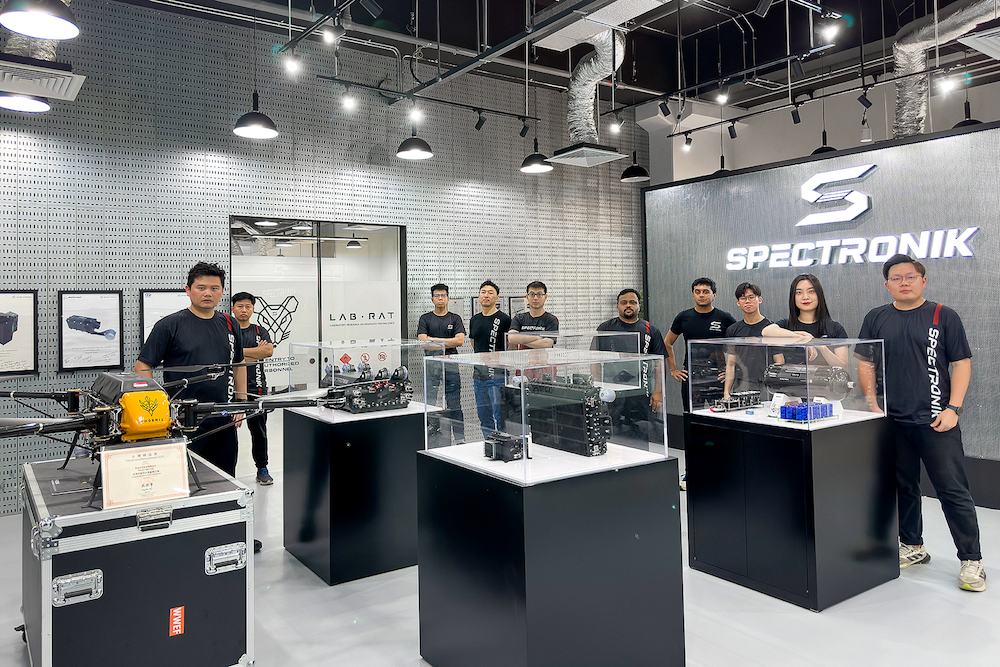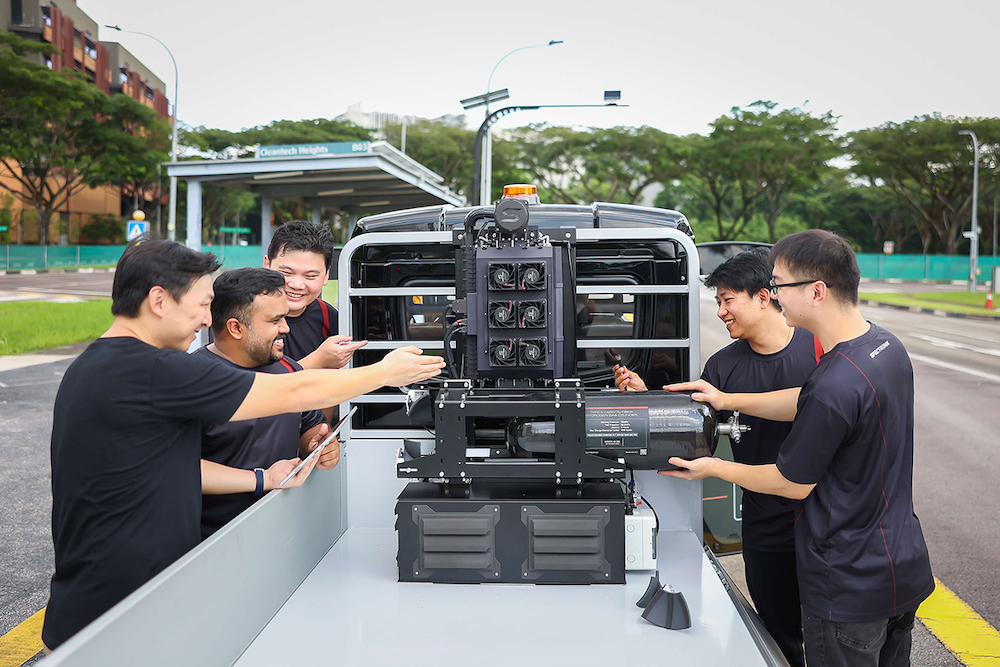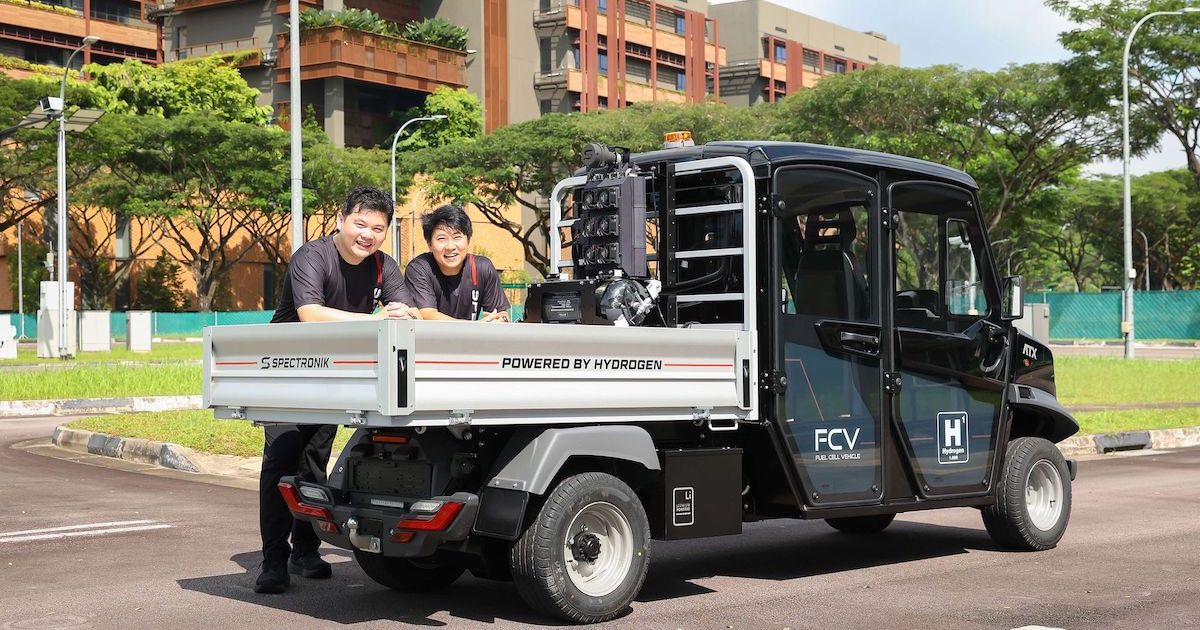In the realm of cutting-edge technologies that promise a greener and more sustainable future, few have captured the imagination quite like hydrogen fuel cells.
These innovative power sources hold the potential to revolutionise transportation and reshape the way we think about energy.
Spectronik, a trailblazing company founded by Jogjaman Jap and Zarli Maung Maung, has been at the forefront of this transformation, pushing the boundaries of hydrogen fuel cell technology and spearheading its integration into a diverse array of applications.
“We met in 2008 at our first workplace,” Jogjaman reminisces. “We were both fresh engineering graduates, and the company assigned us to work on hydrogen fuel cells. We became good friends and kept in touch even after we moved on to different fuel cell companies.”
As the years went by, their expertise in hydrogen fuel cells deepened. They honed their skills, but more importantly, they began to see a niche in the market that had the potential to revolutionise the future of clean energy.
Started out targeting military and industrial drones
Spectronik’s journey began in a time when discussions about global warming, sustainability, and electrification were still nascent.
Back in 2011, the world was far from embracing hydrogen fuel cell technology, which presented a significant challenge for the company.
Preaching the advantages of a hydrogen fuel cell vehicle would be irrelevant. …. The solution was finding a niche application – military and industrial drones, which needed our hydrogen fuel cells in order to fly longer than using lithium batteries.
– Jogjaman Jap, co-founder of Spectronik
The company began by providing fuel cell systems to drone manufacturers who sought to extend the flight time of their creations.
However, it was the subsequent evolution of Spectronik’s offerings that truly set them apart. Following a series of successful collaborations and case studies, end-users began approaching Spectronik with a different request: a full turnkey solution.
Drone service providers, keen on harnessing the benefits of hydrogen-powered drones without the complexity of system integration, found their answer in Spectronik.
Jogjaman elaborates on this pivotal moment: “By then, we had accumulated much experience working with various drone makers, so it was not impossible to make one ourselves.”
The result is Spectronik Phoenix, a hydrogen fuel cell drone capable of flying for up to two hours. In comparison, a battery-powered drone of similar size could manage only 30 to 40 minutes.
Spectronik’s early customers include prominent names like Boeing, China Aerospace, and General Atomics. The appeal of Spectronik’s hydrogen-powered drones to them is crystal clear — it customises its fuel cell systems precisely to their drone requirements, addressing factors such as power, voltage, and form factor.
The primary attraction, however, remains the staggering threefold increase in flight time compared to lithium batteries. This extended flight time unlocks a world of possibilities for these manufacturers, enabling them to explore new mission parameters, expand their range, and enhance their area coverage.
Moreover, it presents a cost-effective alternative to traditional solutions such as manned helicopters. Although the fuel cell costs are higher compared to batteries, early adopters in the military and industrial sectors were fortunately less price-sensitive, providing Spectronik with valuable traction.
What are the benefits of hydrogen fuel cells?

Spectronik’s focus on hydrogen fuel cells has yielded remarkable advantages over traditional battery-powered electric vehicles (EVs), particularly in terms of range and environmental impact.
“In general, there are two advantages,” Jogjaman explains. “Firstly, due to the high gravimetric density (energy content per unit weight) of hydrogen gas, hydrogen fuel cells can typically contain two to three times more energy for the same weight compared to lithium batteries.”
This translates to a longer driving range. Indeed, one of the significant drawbacks of traditional battery-powered electric vehicles is their limited range.
As such, Spectronik’s hydrogen fuel cells promise to change the game by offering extended range capabilities, making long-distance travel and logistics more feasible and efficient.
“Also, when the hydrogen gas in the tank is depleted, refuelling takes just five minutes – similar to gasoline refilling, which we are accustomed to, compared to several hours for battery charging.”
This rapid refuelling time eliminates the need for lengthy charging stops, making hydrogen fuel cells a compelling choice for industries where downtime is costly and inconvenient.
Additionally, Jogjaman pointed out a crucial environmental benefit. “If the hydrogen gas is produced using renewable energy (such as the electrolysis of water using solar panels or wind turbines), then it is possible to have a zero carbon footprint from well-to-wheels, whereas a battery-powered EV will only be as clean as the source of the electric power grid.”
While the benefits of hydrogen fuel cells are evident, Jogjaman delved into another innovative aspect of their technology: refurbishment.
This focus on refurbishment is a gamechanger for the industry, as it addresses a common concern – the upfront cost of adopting hydrogen fuel cell technology.
More than 90 per cent of the components that make up a fuel cell can be recycled. Over time, the fuel cell membrane loses its efficacy to convert hydrogen gas into electricity. This is the only consumable that needs to be replaced.
By designing our fuel cell for ease of refurbishment, the fuel cell can be reused again and again for several lifetimes just by replacing the membrane. This is game-changing as the high upfront cost of a fuel cell can now be amortised over several lifetimes, reducing the cost barrier to fuel cell adoption.
– Jogjaman Jap, co-founder of Spectronik
This approach aligns seamlessly with the principles of a circular economy, reducing waste and promoting sustainability.
Jogjaman also highlighted the practicality of their solution. Refurbishing fuel cells at the point of use is a straightforward and economical process, as they do not contain hazardous chemicals, unlike batteries, which pose greater challenges when it comes to safe disposal or recycling.
Setting the stage for transformation
The streets of Singapore are about to witness a transformative shift in the world of urban mobility, thanks to a groundbreaking collaboration between Spectronik and the Jurong Town Corporation (JTC), which includes upcoming trials of the city-state’s first-ever hydrogen fuel cell-powered light commercial vehicle.
Scheduled for launch in the fourth quarter of this year, these trials hold significant promise for a cleaner, greener future.

Jogjaman outlines three key goals that underpin these trials. The first objective is to stress test Spectronik’s fuel cell technology in a real-world operating environment. The trials will expose the system to the rigours of Singapore’s climate, from scorching heat to torrential rain.
Additionally, they will assess its performance under conditions such as stop-and-start driving, shock and vibration, and exposure to dust and dirt. The data collected will provide invaluable insights into the fuel cell’s durability and lifespan, encouraging potential adoption by new energy vehicle manufacturers.
The second goal is to collaborate with relevant authorities, such as the Land Transport Authority (LTA) and the Singapore Civil Defence Force (SCDF), to ensure the safe integration of this pioneering technology onto Singapore’s public roads.
This collaboration extends beyond the trials to encompass the broader operational and economic feasibility of deploying a fleet of hydrogen fuel cell vehicles in Singapore. Critical factors, including refuelling infrastructure requirements and carbon savings, will be carefully considered.
Lastly, the trials hold the potential to elevate public awareness of hydrogen fuel cell technology and establish Singapore as a “living lab for advanced urban mobility solutions”. This showcases Singapore’s commitment to driving innovation in sustainable transportation and positions it as a global leader in the field.
Spectronik’s ambitious plans go well beyond the trials. Within the next five years, the company aims to introduce a fleet of hydrogen fuel cell-powered light commercial vehicles on public roads. This move aligns with their overarching goal of accelerating the transition to zero-carbon transportation.
These fuel cell-powered vehicles are specifically tailored for fleet applications that are challenging to electrify with traditional batteries. Vans, taxis, and buses, for example, often cover substantial distances in a single day and cannot afford lengthy charging stops.
Hydrogen fuel cells offer a practical solution, with the added advantage of centralised refuelling at depots. This centralised approach significantly reduces the strain on power infrastructure and lowers charging equipment costs, making it a practical and efficient choice for commercial fleets.
Jogjaman emphasises that for private cars with limited daily driving hours and overnight charging options, battery EVs remain an excellent choice. However, for commercial vehicles with demanding schedules and centralised operations, hydrogen fuel cell technology offers a viable, eco-friendly alternative.
Foresees greater adoption in the future
Today, Spectronik has made a name for itself worldwide, manufacturing high-quality portable fuel cells that are made in Singapore.
Their products have reached 33 countries, serving various applications from drones to forklifts, vehicles, water vessels, and more. Notably, the Phoenix Hydrogen Fuel Cell drone received the 2020 Taiwan Excellence Award, while Spectronik-powered eco-cars consistently dominate fuel efficiency competitions.
Jogjaman noted that the adoption of hydrogen fuel cell technology relies heavily on government support and Singapore’s National Hydrogen Strategy, announced in the previous year, further strengthens Spectronik’s belief in the increasing adoption of hydrogen fuel cell technology.
In the near future, they aim to establish an automated fuel cell production and recycling centre in Singapore, aligning with the nation’s vision for advanced manufacturing and green job creation.
Jogjaman envisions an imminent “Hydrogen Inflection Point,” where core material cost reduction, hydrogen infrastructure, technology readiness, government mandates, and regulatory approval converge.
At this juncture, Spectronik may expand its business model to include fleet ownership and leasing of fuel cell vehicles, maximising refurbishment for long-term profitability and environmental sustainability.
Their ultimate goal is clear: to enable cleaner, longer-lasting vehicles that contribute to a greener planet. Spectronik’s commitment to innovation, government collaboration, and sustainability positions them at the forefront of the hydrogen fuel cell revolution, paving the way for a cleaner and more efficient future.
Featured Image Credit: Spectronik








